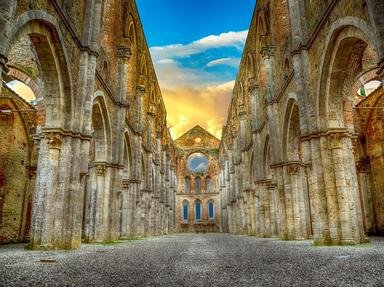Quiz Answer Key and Fun Facts
1. Though his reign began in 936 AD he was not officially crowned emperor by the Papacy until 962 AD. Which man was it?
2. At the Lenten Synod of 1076 AD Pope Gregory VII deposed and excommunicated the emperor. This marked the first time that the Papacy had ever used its spiritual authority to depose a temporal ruler. The emperor saw his support quickly disappear and was forced to perform public penance before the pope at Canossa (Jan 21-23, 1077 AD). Which emperor was it?
3. His formal coronation as emperor (Jun 18, 1155 AD) was performed by Pope Adrian IV, the only English pope to sit upon the throne of Peter. Which emperor was it?
4. Resume: Birth (Dec 26, 1194 AD) and Death (Dec 13, 1250 AD). King of Sicily (1197-1250 AD), ward of Pope Innocent III (1198-1208 AD), Holy Roman Emperor (1215-1250 AD), excommunicated by Pope Gregory IX (Oct 1227 AD), King of Jerusalem (1225-1243 AD), leader of the Sixth Crusade (1228-1229 AD), excommunicated again by Pope Gregory IX (Apr 1239 AD), and declared deposed by Pope Innocent IV (Jul 1245 AD). Who was the emperor that was known as 'Stupor Mundi' (Wonder of the World)?
5. During the political turmoil known as the 'Great Interregnum' (1254-1273 AD) squabbling between the Papacy and the German nobles (and rivalries amongst the nobles themselves) kept the Imperial throne vacant. Many candidates were proposed but none could receive (or bribe) sufficent support. Tiring of the struggle Pope Gregory X demanded an election. The Imperial Diet convened in Frankfurt (September 29, 1273 AD) and finally proclaimed this man 'King of the Romans' on October 1st. Which man was it?
6. This emperor is most famous (or infamous) for the execution of the early Bohemian "Protestant" leader John Hus on July 6, 1415 AD. Which emperor was it?
7. Charles V (r. 1519-1556 AD) held many other titles outside of his position as Holy Roman Emperor. Which of the following titles did he not hold?
8. True or False: Charles VII (r. 1742-1745 AD) was the first non-Hapsburg to hold the title of emperor since 1437 AD.
9. Maria Theresa, Archduchess of Austria and daughter of the late emperor Charles VI (r. 1710-1740 AD) was married to which of the following emperors?
10. True or False: On August 6, 1806 AD the last emperor (Francis II) abdicated his Imperial title, thereby dissolving the political institution that was known as the Holy Roman Empire.
Source: Author
hund
This quiz was reviewed by FunTrivia editor
Exit10 before going online.
Any errors found in FunTrivia content are routinely corrected through our feedback system.

